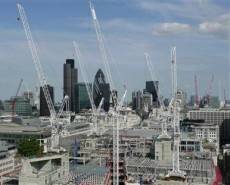November 12, 2014
2015 looks set to deliver lowest volumes of London office space in 20 years
 The total amount of office space under construction in central London is down to 7.7 million sq ft, with next year looking to deliver the lowest volumes of space in twenty years. However, according to the London Office Crane Survey, published by Deloitte Real Estate, 22 new schemes (2.1 million sq ft) have started construction in the last six months, almost double the volume of new space started compared to the previous six months. Steve Johns, head of City leasing at Deloitte Real Estate, said: “The sharpest rise in construction starts is in the City of London, where ten new office buildings are now underway. This includes over a million sq ft in the City core and over 500,000 sq ft in ‘tech city’, accounting for three quarters of the volume of space across all the new schemes we’ve recorded. The West End has also seen 10 new starts, adding 462,000 sq ft to the development pipeline, while Southbank, Midtown and Docklands have seen no new construction this survey.”
The total amount of office space under construction in central London is down to 7.7 million sq ft, with next year looking to deliver the lowest volumes of space in twenty years. However, according to the London Office Crane Survey, published by Deloitte Real Estate, 22 new schemes (2.1 million sq ft) have started construction in the last six months, almost double the volume of new space started compared to the previous six months. Steve Johns, head of City leasing at Deloitte Real Estate, said: “The sharpest rise in construction starts is in the City of London, where ten new office buildings are now underway. This includes over a million sq ft in the City core and over 500,000 sq ft in ‘tech city’, accounting for three quarters of the volume of space across all the new schemes we’ve recorded. The West End has also seen 10 new starts, adding 462,000 sq ft to the development pipeline, while Southbank, Midtown and Docklands have seen no new construction this survey.”
Johns added: “Office construction is down 17 per cent in the last six months, but we have seen 3.7 million sq ft of completions over the last six months, a ten year high. To put that into context, a third of this space is within two City towers, with the remaining space across 22 central London buildings. However, 58 per cent of this space was leased before completion, demonstrating the strength of occupier demand. Similarly, of the total 7.7 million sq ft of space under construction, 41 per cent is already let. Despite a healthy pipeline of activity, 2015 is likely to deliver the lowest volumes of space in 20 years.”
“With occupier demand expected to remain strong we foresee further increases in pre-letting activity, and demand for the best office space to exceed new supply for the next three years. Nevertheless, with over five million sq ft now being demolished – a rise of 18 per cent in six months – developers are racing against the clock to deliver buildings while new supply remains relatively low.”














